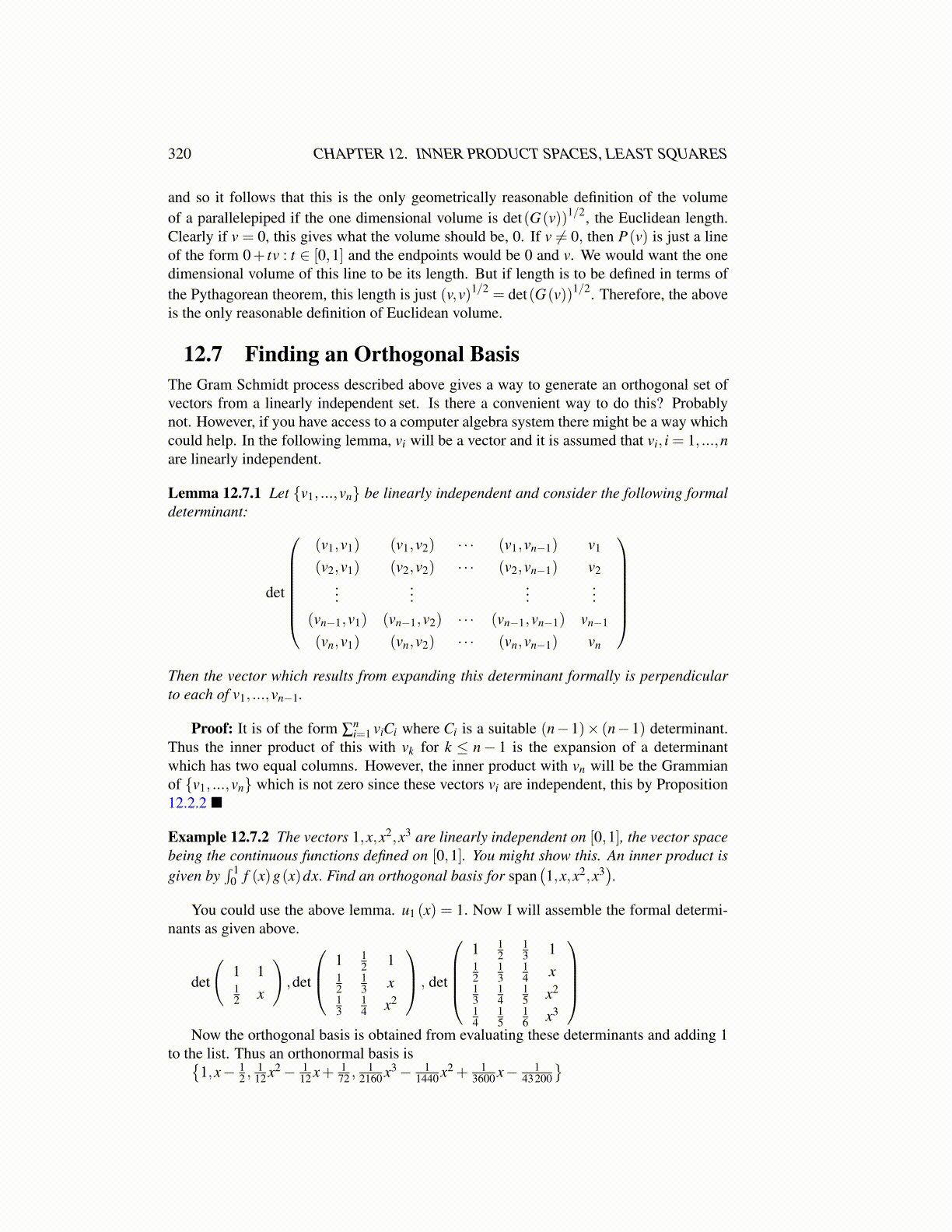
320 CHAPTER 12. INNER PRODUCT SPACES, LEAST SQUARES
and so it follows that this is the only geometrically reasonable definition of the volumeof a parallelepiped if the one dimensional volume is det(G(v))1/2, the Euclidean length.Clearly if v = 0, this gives what the volume should be, 0. If v ̸= 0, then P(v) is just a lineof the form 0+ tv : t ∈ [0,1] and the endpoints would be 0 and v. We would want the onedimensional volume of this line to be its length. But if length is to be defined in terms ofthe Pythagorean theorem, this length is just (v,v)1/2 = det(G(v))1/2. Therefore, the aboveis the only reasonable definition of Euclidean volume.
12.7 Finding an Orthogonal BasisThe Gram Schmidt process described above gives a way to generate an orthogonal set ofvectors from a linearly independent set. Is there a convenient way to do this? Probablynot. However, if you have access to a computer algebra system there might be a way whichcould help. In the following lemma, vi will be a vector and it is assumed that vi, i = 1, ...,nare linearly independent.
Lemma 12.7.1 Let {v1, ...,vn} be linearly independent and consider the following formaldeterminant:
det
(v1,v1) (v1,v2) · · · (v1,vn−1) v1
(v2,v1) (v2,v2) · · · (v2,vn−1) v2...
......
...(vn−1,v1) (vn−1,v2) · · · (vn−1,vn−1) vn−1
(vn,v1) (vn,v2) · · · (vn,vn−1) vn
Then the vector which results from expanding this determinant formally is perpendicularto each of v1, ...,vn−1.
Proof: It is of the form ∑ni=1 viCi where Ci is a suitable (n−1)× (n−1) determinant.
Thus the inner product of this with vk for k ≤ n− 1 is the expansion of a determinantwhich has two equal columns. However, the inner product with vn will be the Grammianof {v1, ...,vn} which is not zero since these vectors vi are independent, this by Proposition12.2.2 ■
Example 12.7.2 The vectors 1,x,x2,x3 are linearly independent on [0,1], the vector spacebeing the continuous functions defined on [0,1]. You might show this. An inner product isgiven by
∫ 10 f (x)g(x)dx. Find an orthogonal basis for span
(1,x,x2,x3
).
You could use the above lemma. u1 (x) = 1. Now I will assemble the formal determi-nants as given above.
det
(1 112 x
),det
1 12 1
12
13 x
13
14 x2
, det
1 1
213 1
12
13
14 x
13
14
15 x2
14
15
16 x3
Now the orthogonal basis is obtained from evaluating these determinants and adding 1
to the list. Thus an orthonormal basis is{1,x− 1
2 ,1
12 x2− 112 x+ 1
72 ,1
2160 x3− 11440 x2 + 1
3600 x− 143200
}